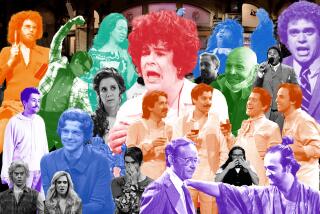Wilshire Center
David Hockney’s prints create an uncanny tension between masterful drawing and a real world seen with the stylized directness of Matisse. His work needs little description. Hockney’s pools and languid male bathers have become popular emblems of the California good life, and who isn’t familiar with the many incarnations of his model and friend Celia?
A collection of lithographs and etchings dating mostly from the ‘70s and ‘80s offer yet another look at Hockney’s polyglot hand. There are lithos that look like fragile pencil portraits and no matter how many times you see them, “Brooke Hopper,” “Henry With Tulips” and the amazingly crisp “Joe McDonald” reaffirm Hockney’s ability to make every mark tell, as well as his command over line and subtle light. Celia is described with velvety and faultless verisimilitude in “Celia on an Office Chair,” rendered as a playful abstraction of dense black lines in “Celia Amused,” and the vehicle for Hockney’s most recent fascination for late Picasso Expressionism in “Image of Celia,” with its displaced eyes and features that refuse to stay put.
In the ‘80s Hockney began making handsome composite scenes from hundreds of displaced Polaroid snapshots, investigating perspective and how the eye and mind read depth. He grafts this same sense of bending and fragmented space onto several colorful, romping lithos of a courtyard in Mexico. In three versions of the same scene, we watch Hockney’s transformative vision at work. The first is tame, loose realism, the last a cacophony of slipping and sliding colors, planes and shapes related most to analytic Cubism.
Though detractors chastise Hockney for making commercial Pablum, he may well be one of the most innately facile draftsmen working today. Even in this small sample of printed work, it’s hard not to acknowledge his relentless and genuine experimentation, clarity and tour de force technique. (Richard Green Gallery, 834 La Brea Ave., to July 22.)
More to Read
The biggest entertainment stories
Get our big stories about Hollywood, film, television, music, arts, culture and more right in your inbox as soon as they publish.
You may occasionally receive promotional content from the Los Angeles Times.










